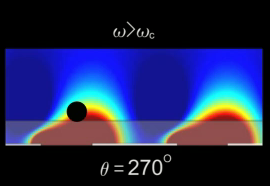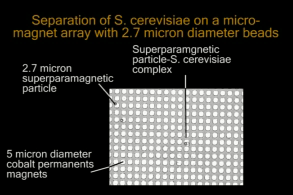|
|
|
Current News |
|
Chemistry A to Z |
|
About Internetchemistry |
New system would use rotating magnetic field to detect pathogens |
|
Because different pathogens could be attracted to specific-size magnetic particles and the new technique can selectively separate particles by size, the method could be used to diagnose the presence of many diseases in a single sample, said Gil Lee, a professor of chemical and biomedical engineering at Purdue. The micron-size magnetic particles have been coated with antibodies that attract certain pathogens and are then mixed with blood samples from patients. A critical piece of the technology is a microchip containing an array of metal disks as wide as 5 microns, or millionths of a meter. The magnetic particles are dispersed in a liquid placed in a container housing the chip. The container is surrounded by three electromagnets energized in sequence to produce a rotating magnetic field. |
|
As the magnetic field rotates, the particles move from one disk to another until they are separated from the rest of the sample. Rotating the magnetic field at specific speeds separates only particles of certain sizes, meaning pathogens attached to those particles would be separated from the sample by varying the rotation speed, Lee said. In recent experiments, samples containing magnetic particles attached to yeast were placed inside the rotating magnetic field and separated from the rest of the samples. Findings are detailed in a research paper appearing online this month in Lab on a Chip magazine and in the December print edition of the publication. The paper was written by assistant professor Benjamin Yellen, graduate students Randall Erb and H. Son, and undergraduate student R. Hewlin Jr., all from Duke University's Department of Mechanical Engineering and Materials Science, and postdoctoral fellow Hao Shang and Lee, both from Purdue's School of Chemical Engineering and Weldon School of Biomedical Engineering. The technique, called non-linear magnetophoretic separation, works using an array of disks made of cobalt and coated with chromium to prevent corrosion. The disks are regularly, or periodically, spaced on the surface of the silicon chip. An advantage of the non-linear magnetophoresis technique is that it can be used to simultaneously separate and identify pathogens with a sensitivity up to a million times higher than the "solid phase immunoassays" commonly used today for human diagnostics, said Shang, co-founder of MagSense Life Sciences Inc. and a research scientist at the company, located at the Purdue Research Park. The company is developing a new method to produce the magnetic particles. The biotechnology industry currently uses magnetic particles to make drugs by separating components in biological materials. The particles attract specific types of molecules, such as proteins and DNA, and then a magnet is used to separate them from the rest of the sample. The new approach, however, aims to use the particles not for research but for medical diagnostics or possibly to detect biological materials in environmental samples. The micron-size magnetic particles, which are made of thousands of nanometer-size particles, have a property called superparamagnetism. This means the particles are not magnetic unless they are in a magnetic field, so they can be mixed in a solution without attracting each other and clumping together, which is critical for them to be distributed uniformly throughout the solution. But as soon as the rotating magnetic field is applied, the particles become magnetic, which enables them to be separated. "What some people are doing very successfully is attaching antibodies that recognize pathogens like bacteria and viruses to these magnetic particles," Lee said. "One of the things we've been working on for quite a long time is to identify many different pathogens simultaneously." Such an innovation represents a powerful new tool for medical diagnostics. "When you walk into a doctor's office, the problem is that it could be one of five or six different pathogens giving you the symptoms," Lee said. "The doctor cannot determine which pathogen you have, so they simply give you a broad-spectrum antibiotic or tell you to go home and get some rest. There clearly is a need for technology that can recognize multiple pathogens simultaneously and at very low levels. It is likely they will be chip-based technologies that are easy to implement in medical environments." The particles are said to move in a "non-linear" fashion because their motion does not simply increase as the speed of the rotating magnetic field increases. "There is a surprising effect where at some point the particles stop moving due to their size or what they are attached to, and we can use this effect to our advantage," Lee said. "This effect will allow us to quickly sort through a million particles and say that one's got a certain bacterium on it, that one's got a virus on it, and so on." The disks are aligned so that their poles point in the same direction. The particles are drawn across the chip as they are attracted by the magnetic fields emanating from the poles and resulting from the external rotating magnetic field. Different size particles have different "critical frequencies," which means they are moved across the chip by rotating the external magnetic field at specific speeds matching those frequencies. "So, at a certain frequency, you will see larger particles moving and smaller particles just sort of jitter back and forth," Lee said. This frequency is higher for larger particles than it is for smaller particles, so speeding up and slowing down the rotation of the external magnetic field causes particles to move based on their size. "Say we would like to sort out 50 different magnetic particle sizes, and we could put a different antibody on each one," Lee said. "Then each one would react with a different pathogen. It might have one for dengue virus, one for West Nile virus, and that way I could add them to a blood sample from a patient and sort them out within two minutes." Lee's work is based at the Birck Nanotechnology Center at Purdue's Discovery Park. The research has been supported by the Institute for Nanoelectronics and Computing, funded by NASA and located at Discovery Park. Hewlin's participation as an undergraduate was supported by the National Science Foundation. |
|
|
|


